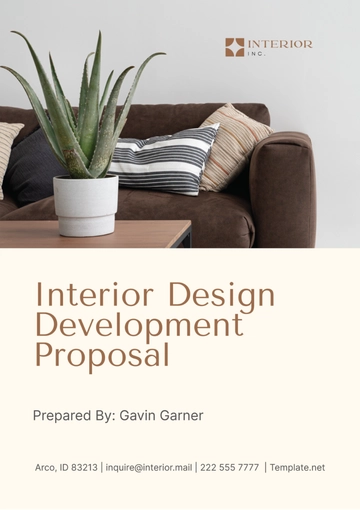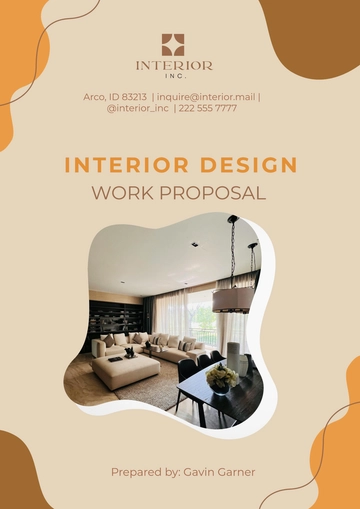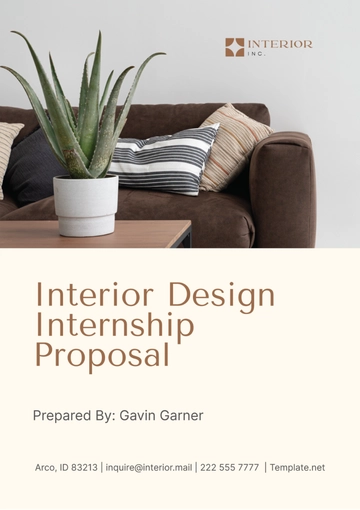Free Interior Design Training Proposal

I. Introduction
A. Overview
[Your Company Name] is delighted to present this comprehensive Interior Design Training Proposal tailored specifically for [Client Name]. Our proposal outlines a structured training program designed to enhance the skills and knowledge of interior design professionals within your esteemed organization.
In today's competitive landscape, staying updated with industry trends and mastering the latest techniques is crucial for success in the field of interior design. Recognizing this, [Your Company Name] has meticulously crafted a training curriculum that encompasses both fundamental principles and advanced concepts, ensuring participants are equipped with the expertise needed to excel in their roles.
Through interactive learning modules, hands-on workshops, and expert guidance from seasoned professionals, our training program aims to empower your team with the tools and techniques necessary to deliver exceptional design solutions and elevate your organization's reputation in the market.
B. Background
Established in [Year], [Your Company Name] has emerged as a leading provider of specialized training solutions for professionals across diverse industries. With a team of experienced instructors and a commitment to excellence, we have earned the trust of numerous organizations seeking to invest in the continuous development of their workforce.
[Client Name] is a respected entity renowned for its commitment to innovation and excellence in interior design. With a team of talented designers and a portfolio of prestigious projects, [Client Name] has established itself as a trailblazer in the industry. By partnering with [Your Company Name], [Client Name] demonstrates its dedication to fostering a culture of learning and growth within its organization.
II. Objectives
A. General Objectives
To provide comprehensive training in interior design principles, techniques, and trends.
To enhance participants' proficiency in space planning, color theory, materials selection, and project management.
To equip participants with practical skills for effective client communication and project execution.
To foster creativity and innovation in interior design solutions.
B. Specific Objectives
Develop a deeper understanding of design fundamentals through theoretical and practical exercises.
Master the use of industry-standard design software and tools for concept development and visualization.
Explore sustainable design practices and their integration into design projects.
Enhance collaboration and teamwork skills through group projects and interactive sessions.
Stay abreast of the latest industry trends, emerging technologies, and innovative design approaches.
III. Scope of Work
A. Training Sessions
Introduction to Interior Design Principles
Overview of fundamental design concepts and principles.
Exploration of historical and contemporary design styles.
Introduction to elements and principles of design: line, shape, form, texture, color, balance, rhythm, and harmony.
Space Planning and Layout Design
Understanding spatial relationships and functional requirements.
Techniques for optimizing space utilization and flow.
Introduction to floor plans, elevations, and 3D modeling for space visualization.
Color Theory and Application
Principles of color theory: hue, value, saturation, and color harmony.
Psychological effects of color and its impact on spatial perception.
Practical applications of color in interior design through case studies and exercises.
Materials Selection and Specification
Overview of materials commonly used in interior design: fabrics, finishes, flooring, and furnishings.
Factors influencing material selection: durability, sustainability, aesthetics, and budget.
Techniques for specifying materials based on project requirements and client preferences.
Furniture Design and Styling
Understanding furniture styles, proportions, and ergonomics.
Principles of furniture arrangement and space planning.
Techniques for selecting and integrating furniture pieces to enhance interior design schemes.
Lighting Design Techniques
Importance of lighting in interior spaces: functionality, aesthetics, and mood.
Types of lighting: ambient, task, accent, and decorative lighting.
Strategies for lighting design, including fixture selection, placement, and control.
Sustainable Design Practices
Overview of sustainable design principles and green building standards.
Strategies for incorporating sustainable materials, energy-efficient systems, and passive design strategies.
Case studies highlighting successful implementation of sustainable design principles.
Client Communication and Presentation
Effective communication strategies for engaging with clients, understanding their needs, and presenting design concepts.
Techniques for creating compelling presentations: mood boards, renderings, and digital presentations.
Best practices for client meetings, negotiations, and project documentation.
Project Management for Interior Designers
Overview of project management processes: initiation, planning, execution, monitoring, and closing.
Budgeting and cost estimation for interior design projects.
Time management techniques, resource allocation, and risk mitigation strategies.
Hands-on Workshops and Case Studies
Practical workshops and hands-on exercises to reinforce learning and apply concepts in real-world scenarios.
Analysis of case studies showcasing successful interior design projects, challenges faced, and lessons learned.
B. Training Methodology
Our training methodology is designed to be interactive, engaging, and tailored to the specific needs of interior design professionals. The sessions will incorporate a blend of the following approaches:
Interactive Lectures: Expert instructors will deliver engaging lectures covering key concepts and principles in interior design.
Practical Exercises: Participants will engage in hands-on exercises to apply theoretical knowledge and enhance practical skills.
Workshops: Interactive workshops will allow participants to collaborate on design projects, receive feedback, and refine their ideas.
Case Studies: Real-world case studies will be analyzed to understand best practices, challenges, and solutions in interior design projects.
Group Discussions: Opportunities for group discussions will facilitate knowledge sharing, peer learning, and brainstorming sessions.
Field Visits: Visits to design studios, exhibitions, or architectural landmarks will provide practical insights and inspiration for participants.
IV. Training Delivery
A. Duration and Frequency
The training program is designed to be flexible and accommodating to the participants' schedules. It will span [Insert duration e.g., 8 weeks], with sessions held [Insert frequency e.g., twice a week]. This frequency allows for a balanced approach to learning, ensuring participants have ample time to absorb the material between sessions.
B. Mode of Delivery
The training sessions can be delivered in various modes to suit [Client Name]'s preferences and logistical considerations:
In-person: Conducted at [Client Name]'s premises or at an external venue suitable for conducting training activities. In-person sessions offer the opportunity for hands-on learning and direct interaction with instructors and fellow participants.
Virtual: Hosted on a secure online platform with interactive features for optimal engagement. Virtual sessions provide the flexibility for participants to attend from any location, minimizing travel time and logistical constraints.
Hybrid: A combination of in-person and virtual delivery, allowing participants to choose the mode that best suits their needs. Hybrid sessions offer the benefits of both in-person interactions and the convenience of remote learning.
C. Venue
In-person sessions can be conducted at [Client Name]'s premises, providing a familiar and convenient setting for participants. Alternatively, sessions can be held at an external venue selected based on factors such as accessibility, facilities, and capacity to accommodate the training activities.
For virtual sessions, participants can join from any location with internet access. The online platform will be chosen based on its reliability, security features, and compatibility with the training content and interactive tools.
D. Training Materials
Participants will receive a comprehensive set of training materials to support their learning journey, including:
Textbooks and reference materials covering key concepts and techniques in interior design.
Handouts and worksheets for in-class exercises and activities.
Design software licenses (if applicable) to facilitate hands-on practice and project work.
Access to online resources such as video tutorials, webinars, and forums for additional learning and support.
Any additional materials or tools required for specific sessions will be provided in advance to ensure participants are fully prepared.
V. Benefits
A. Individual Benefits
Enhanced Skills and Knowledge
Participants will undergo comprehensive training covering a wide range of interior design principles, techniques, and best practices. This includes gaining proficiency in space planning, color theory, materials selection, and project management.
Practical exercises and real-world case studies will provide hands-on experience, allowing participants to apply theoretical knowledge to practical design challenges.
By mastering industry-standard design software and tools, participants will develop technical skills essential for modern interior design practice.
Career Advancement Opportunities
The acquisition of advanced skills and knowledge will position participants for career growth within the interior design industry. They will be better equipped to take on leadership roles, manage complex projects, and explore specialized areas such as sustainable design or hospitality design.
Networking opportunities during training sessions, industry events, and online forums will facilitate connections with peers, mentors, and potential employers, opening doors to new career opportunities and collaborations.
Increased Confidence
Through continuous learning and skill development, participants will gain confidence in their abilities to tackle design challenges and deliver impactful solutions.
Feedback from instructors and peers will provide valuable insights and validation, further boosting participants' confidence in their design capabilities.
Networking and Collaboration
Training sessions serve as a platform for participants to connect with fellow professionals, share experiences, and exchange ideas. This collaborative environment fosters a sense of community and support among industry peers.
Building a strong professional network can lead to collaboration opportunities, referrals, and partnerships, enriching participants' careers and expanding their professional circles.
B. Organizational Benefits
Improved Design Outcomes
Investing in training ensures that your organization's design team is equipped with the latest knowledge, skills, and tools to deliver high-quality design solutions.
Enhanced creativity, innovation, and attention to detail result in design outcomes that exceed client expectations and elevate your organization's reputation in the industry.
Enhanced Efficiency and Productivity
Well-trained professionals are more efficient in their work processes, leading to streamlined project workflows, reduced rework, and faster project delivery.
Effective project management skills acquired during training enable better resource allocation, task prioritization, and time management, further enhancing efficiency and productivity.
Competitive Edge
By staying abreast of industry trends and emerging technologies, your organization maintains a competitive edge in the market.
Offering innovative design solutions backed by a skilled and knowledgeable team sets your organization apart from competitors, attracting clients and projects of higher value and prestige.
Employee Morale and Retention
Providing opportunities for professional development demonstrates your organization's commitment to employee growth and well-being.
Investing in employee training fosters a positive work environment, boosts morale, and increases employee satisfaction and loyalty, leading to higher retention rates and reduced turnover costs.
VI. Investment
A. Training Fees
The total investment for the Interior Design Training Program is [$20,500]. This fee covers all training materials, instructor fees, administrative costs, and any additional resources provided during the program.
B. Payment Terms
Payment terms for the training program can be customized to [Client Name]'s preferences and financial constraints.
A typical payment schedule may include a [50%] deposit upon signing the training agreement, with the remaining balance due in installments throughout the duration of the program or upon completion.
C. Additional Costs
In addition to the training fees, [Client Name] may incur additional costs such as venue rental (if applicable), travel expenses for instructors (if sessions are conducted in-person at an external venue), and any optional add-on services requested to enhance the training experience, such as guest lectures or field trips.
VII. Conclusion
[Your Company Name] is dedicated to delivering exceptional training programs tailored to meet the unique needs of [Client Name]. Our Interior Design Training Proposal offers a structured curriculum designed to empower participants with the skills, knowledge, and confidence needed to excel in the field of interior design.
By partnering with [Your Company Name], [Client Name] demonstrates its commitment to investing in the professional development of its interior design team. We are confident that our training program will deliver tangible benefits, both at the individual and organizational levels, contributing to the success and competitiveness of [Client Name] in the industry.
We invite [Client Name] to take advantage of this opportunity to enhance the capabilities of its interior design professionals and drive innovation and excellence within the organization. Together, we can unlock new opportunities for growth, creativity, and success in the dynamic world of interior design.
For further inquiries or to proceed with scheduling the training sessions, please contact:
[Your Name]
[Your Company Email]
[Your Company Number]
Thank you for considering [Your Company Name] as your training partner. We look forward to the opportunity to collaborate and support your training objectives.
- 100% Customizable, free editor
- Access 1 Million+ Templates, photo’s & graphics
- Download or share as a template
- Click and replace photos, graphics, text, backgrounds
- Resize, crop, AI write & more
- Access advanced editor
Elevate employee skills with Template.net's Interior Design Training Proposal Template. This customizable document provides a compelling format for proposing training programs aimed at enhancing the skills and knowledge of interior design staff. Present training objectives, methods, and benefits to management effectively. Editable in our Ai Editor Tool for seamless customization to align with your interior design training needs and goals.
You may also like
- Business Proposal
- Research Proposal
- Proposal Request
- Project Proposal
- Grant Proposal
- Photography Proposal
- Job Proposal
- Budget Proposal
- Marketing Proposal
- Branding Proposal
- Advertising Proposal
- Sales Proposal
- Startup Proposal
- Event Proposal
- Creative Proposal
- Restaurant Proposal
- Blank Proposal
- One Page Proposal
- Proposal Report
- IT Proposal
- Non Profit Proposal
- Training Proposal
- Construction Proposal
- School Proposal
- Cleaning Proposal
- Contract Proposal
- HR Proposal
- Travel Agency Proposal
- Small Business Proposal
- Investment Proposal
- Bid Proposal
- Retail Business Proposal
- Sponsorship Proposal
- Academic Proposal
- Partnership Proposal
- Work Proposal
- Agency Proposal
- University Proposal
- Accounting Proposal
- Real Estate Proposal
- Hotel Proposal
- Product Proposal
- Advertising Agency Proposal
- Development Proposal
- Loan Proposal
- Website Proposal
- Nursing Home Proposal
- Financial Proposal
- Salon Proposal
- Freelancer Proposal
- Funding Proposal
- Work from Home Proposal
- Company Proposal
- Consulting Proposal
- Educational Proposal
- Construction Bid Proposal
- Interior Design Proposal
- New Product Proposal
- Sports Proposal
- Corporate Proposal
- Food Proposal
- Property Proposal
- Maintenance Proposal
- Purchase Proposal
- Rental Proposal
- Recruitment Proposal
- Social Media Proposal
- Travel Proposal
- Trip Proposal
- Software Proposal
- Conference Proposal
- Graphic Design Proposal
- Law Firm Proposal
- Medical Proposal
- Music Proposal
- Pricing Proposal
- SEO Proposal
- Strategy Proposal
- Technical Proposal
- Coaching Proposal
- Ecommerce Proposal
- Fundraising Proposal
- Landscaping Proposal
- Charity Proposal
- Contractor Proposal
- Exhibition Proposal
- Art Proposal
- Mobile Proposal
- Equipment Proposal
- Student Proposal
- Engineering Proposal
- Business Proposal
























